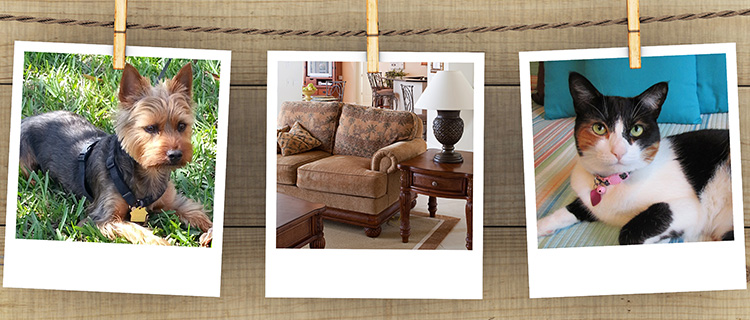This seems like the PURRRFECT time to re-explore ways to PET PROOF your home as the 13th Annual 2016 Humane Society of the Nature Coast Fur Ball fundraiser event is soon approaching.
According to the 2015-2016 APPA National Pet Owners Survey, if you are one of the 79.7 million households in the United States that cohabitants with a “furry friend” – 65% of ALL households do – you may not be surprised to hear that pet-parent’s spending is in excess of $60 billion this year. I am one of those households! Let’s face it, we work very hard to keep our furry friends happy and healthy.
Anyone who owns a dog or a cat soon understands that a certain amount of awareness comes with pet ownership. Puppies and kittens can get into everything and escape thru the tiniest opening. Some of the more-common known dangers are toxic plants and food. From the kitchen to the great outdoors, and everywhere in between, your home has some expected and unexpected hazards that Fido and Tiger may encounter.
There is good news: A lot of the potential dangers are things your pet will ignore. More good news: You can easily eliminate most of these potential problems. Some of the rules are simply good old common sense, like keeping small objects and items that can easily be eaten or swallowed out of their way. As for other dangers, just look around from your pet’s point of view and see what objects might be tempting and troublesome. Just like you would baby-proof a home, the same is true for pet-proofing.
Also remember, while dogs may seem to be more trouble-prone than cats, cats can get in far more – and higher – spaces in your home! There is even a BONUS to these precautions: A NEATER HOME. Storing things safely away after using them is much easier than coaxing it away from a determined pet that may swallow the object. BLUE, my 3 year-old Silky-Terrier, was the worst offender of this! We all want to keep those emergency trips to the Vet at a minimum.
Hazards in the kitchen
- Many foods we enjoy can be harmful or potentially fatal to dogs and cats. The following items should be kept off your furry friend’s menu: grapes/raisins, chocolate, onions, coffee grounds, tea, macadamia nuts, alcohol, fatty foods, salt, avocado, garlic, chewing gum, candy and breath fresheners containing xylitol. Of course, keep garbage out of a pet’s reach as rotting food contains mold or bacteria that could cause food poisoning.
- Many household cleaners can be safely used around cats and dogs. However, be sure to read the labels carefully. If the label indicates “keep pets and children away from area until dry”, follow these directions to prevent possible health risks. Products containing bleach can cause stomach upset, drooling, vomiting, diarrhea and/or severe burns, if swallowed. Also, some detergents can produce a similar reaction and cats can be particularly sensitive to products that contain phenols. As a general rule, store all cleaning products in a secure location, in their original packaging or in a clearly labeled and well-sealed container.
- As with household cleaners, pesticides need to be monitored just as carefully. Flea and tick products labeled “for use on dogs only” should not be applied to cats or any other species. Always consult your Vet about the safe use of these products for your pet. To add to the dangers, if rat or mouse poison is ingested, serious or even life-threatening problems can result. Therefore, keep all rodenticides completely inaccessible and in a secure location.
WHAT TO DO IF YOUR PET IS POISONED?
Don’t wait! Time is critical for successfully treating accidental poisoning. Call you Vet or the ASPCA Animal Poison Control Center at 888-426-4435. Be prepared to state your dog’s breed, age, weight and any symptoms. Have the product container or plant sample nearby to assist with identification so the appropriate treatment recommendations can be made.
We hope you found this post to be helpful, informative and interesting… Watch for our next BLOG POST on August 25th as we continue our 5-Part Series on Pet-Proofing Your Home. To learn more about Tampa Bay area homes for sale in Spring Hill and Brooksville, located in Hernando County, Florida, visit us at www.GailSellsFloridaHomes.com… Be sure to check out our custom, state-of-the-art, MLS Map Search Feature, which you’ll find to be fully functional on any and all of your devices!
To learn more about the upcoming Fur Ball on Sept. 17th, being held at Silverthorn Country Club, be sure to visit http://humanerescue.org/event/13th-annual-fur-ball/ … As one of the event’s main sponsors, I hope to see YOU there!
Until then… it’s all about YOU!

